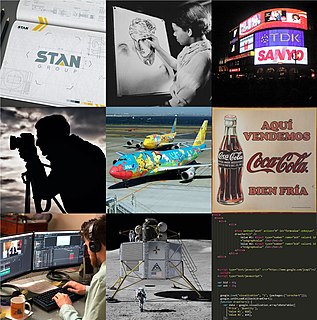
Graphic design is the art, profession and academic discipline whose activity consists in projecting visual communications intended to transmit specific messages to social groups, with specific objectives. Therefore, it is an interdisciplinary branch of design whose foundations and objectives revolve around the definition of problems and the determination of objectives for decision-making, through creativity, innovation and lateral thinking along with digital tools, transforming them for proper interpretation. This activity helps in the optimization of graphic communications (see also communication design). It is also known as visual communication design, visual design or editorial design.
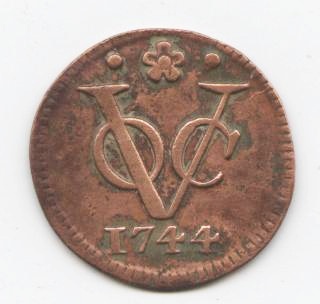
A logo is a graphic mark, emblem, or symbol used to aid and promote public identification and recognition. It may be of an abstract or figurative design or include the text of the name it represents as in a wordmark.
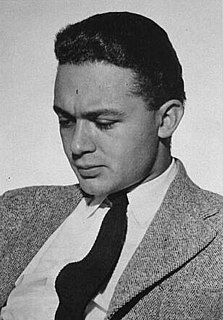
Paul Rand was an American art director and graphic designer, best known for his corporate logo designs, including the logos for IBM, UPS, Enron, Morningstar, Inc., Westinghouse, ABC, and NeXT. He was one of the first American commercial artists to embrace and practice the Swiss Style of graphic design.
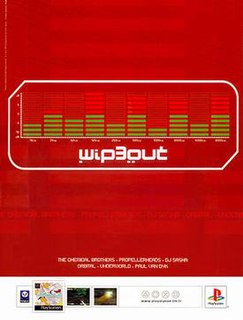
The Designers Republic is a British graphic design studio based in Sheffield, England, founded in 1986 by Ian Anderson and Nick Phillips. They are best known for electronic music logos, album artwork, and anti-establishment aesthetics, embracing "brash consumerism and the uniform style of corporate brands". Work by tDR is held in the permanent collections of the Museum of Modern Art and the Victoria and Albert Museum.
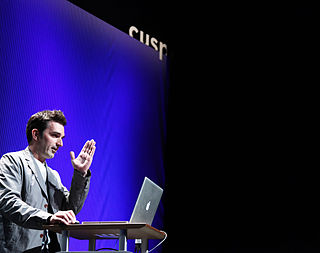
Christopher Simmons is a Canadian-born, San Francisco-based graphic designer, writer and educator.
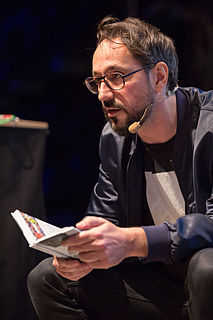
Fons Hickmann is a German graphic designer and professor of Communication Design at the Berlin University of the Arts. He is the founder and director of the design studio Fons Hickmann m23.
Graphic design careers include creative director, art director, art production manager, brand identity developer, illustrator and layout artist.

The American Institute of Graphic Arts (AIGA) is a professional organization for design. Its members practice all forms of communication design, including graphic design, typography, interaction design, user experience, branding and identity. The organization's aim is to be the standard bearer for professional ethics and practices for the design profession. There are currently over 18,000 members and 73 chapters, and more than 200 student groups around the United States. In 2005, AIGA changed its name to “AIGA, the professional association for design,” dropping the "American Institute of Graphic Arts" to welcome all design disciplines.

Wolff Olins is a brand consultancy, based in London, New York City and San Francisco. Founded in 1965, it now employs 150 designers, strategists, technologists, programme managers and educators, and has been part of the Omnicom Group since 2001.
Visual brand language is the unique "alphabet" of design elements – such as shape, color, materials, finish, typography and composition – which directly and subliminally communicate a company's values and personality through compelling imagery and design style. This "alphabet", properly designed, results in an emotional connection between the brand and the consumer. Visual brand language is a key ingredient necessary to make an authentic and convincing brand strategy that can be applied uniquely and creatively in all forms of brand communications to both employees and customers. Successful Visual Brand Language creates a memorable experience for the consumer, encouraging repeat business and boosting the company's economic health. It is a long-term creative solution that can be leveraged by an executive team to showcase their brand's unique personality.
The Graphex National Design Awards is a biennial competition in Canada to celebrate and showcase the best examples of visual communication design. It was founded in 1977 by the Society of Graphic Designers of Canada. Awards are given to creative professionals from various design disciplines in following categories:

Chermayeff & Geismar & Haviv is a New York-based branding and graphic design firm. It is currently led by partners Tom Geismar and Sagi Haviv.

Brand Union was a global brand and creative design consultancy agency, composed of about 500 people across 25 offices. Brand Union was a wholly owned subsidiary of the WPP Group.

Martin John Lambie-Nairn was an English designer. He was the founder of his branding agency Lambie-Nairn and was the creative director of branding agency ML-N. He is recognised for having redefined television brand identity design, being the first to embrace computer technologies to apply branding to screen-based media.

Sagi Haviv is a New York-based graphic designer and a partner in the design firm Chermayeff & Geismar & Haviv. Called a "logo prodigy" by The New Yorker, and a "wunderkind" by Out magazine, he is best known for having designed the trademarks and visual identities for brands and institutions such as Discovery, Inc.'s online streaming service Discovery+, the United States Olympic & Paralympic Museum, the US Open tennis tournament, Conservation International, Harvard University Press, L.A. Reid's Hitco Entertainment, Leonard Bernstein at 100, the John D. and Catherine T. MacArthur Foundation, the Milwaukee Institute of Art & Design, the International Tchaikovsky Competition, and Women's World Banking.
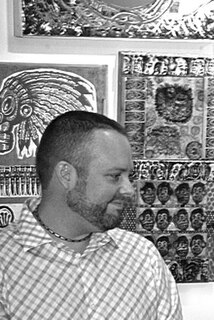
Gregory Stanislaus Bennett Jr. is an American graphic designer and artist based in York, Pennsylvania, USA. Bennett studied graphic design at the Art Institute of York where he graduated from in 1999. He is best known for his imaginative and highly conceptual branding, corporate identity, packaging and cause-related poster projects.
Marcello Minale was a world-renowned Italian designer, writer and a former international oarsman.

Lella Vignelli was an Italian designer who was the founder of Vignelli Associates. She had "a lifelong collaborative working relationship" with her husband, Massimo Vignelli. She was known to be the business arm of Vignelli Associates and she played a key role in the success of the design firm.
Bill Gardner is an American business owner, graphic designer, speaker and author who founded Gardner Design and LogoLounge.

The British Rail Corporate Identity Manual is a corporate identity guide created in 1965 by British Rail. It was conceived in 1964, and finished in July 1965 by British Rail's Design Research Unit, and introduced British Rail's enduring double arrow logo, created by Gerald Barney and still in use today as the logo for National Rail. The manual spanned four volumes, and was created as part of a comprehensive redesign of British Rail following the Beeching Cuts as part of a plan to attract more passengers. It is noted as a piece of British design history.














